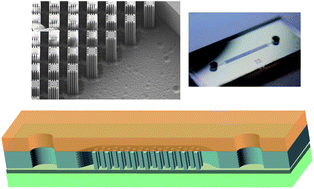Solid phase extraction of DNA from biological samples in a post-based, high surface area poly(methyl methacrylate) (PMMA) microdevice
Abstract
This work describes the performance of poly(methyl methacrylate) (PMMA) microfluidic DNA

* Corresponding authors
a
Department of Chemistry, University of Virginia, McCormick Road, P.O. Box 400319, Charlottesville, Virginia, USA
E-mail:
landers@virginia.edu
Fax: +1 434-243-8852
Tel: +1 434-243-8658
b Department of Pathology, University of Virginia Health Science Center, Charlottesville, Virginia, USA
c Department of Mechanical Engineering, University of Virginia, Charlottesville, Virginia, USA
d HT Microanalytical, Inc., Albuquerque, New Mexico, USA
e Department of Mechanical Engineering, University of California, Santa Barbara, Santa Barbara, California, USA
This work describes the performance of poly(methyl methacrylate) (PMMA) microfluidic DNA

 Please wait while we load your content...
Something went wrong. Try again?
Please wait while we load your content...
Something went wrong. Try again?
C. R. Reedy, C. W. Price, J. Sniegowski, J. P. Ferrance, M. Begley and J. P. Landers, Lab Chip, 2011, 11, 1603 DOI: 10.1039/C0LC00597E
To request permission to reproduce material from this article, please go to the Copyright Clearance Center request page.
If you are an author contributing to an RSC publication, you do not need to request permission provided correct acknowledgement is given.
If you are the author of this article, you do not need to request permission to reproduce figures and diagrams provided correct acknowledgement is given. If you want to reproduce the whole article in a third-party publication (excluding your thesis/dissertation for which permission is not required) please go to the Copyright Clearance Center request page.
Read more about how to correctly acknowledge RSC content.
 Fetching data from CrossRef.
Fetching data from CrossRef.
This may take some time to load.
Loading related content
